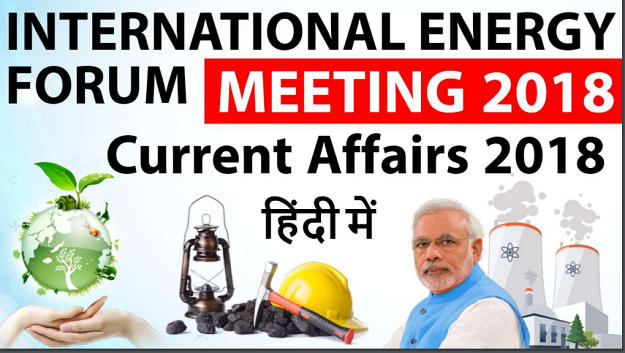Table of Contents
International Energy Forum Meeting 2018
•World’s largest recurring gathering of energy ministers. (set up in 1991) Has 72 member countries.
•Secretariat – Riyadh, Saudi Arabia.
•The 16th International Energy Forum (IEF) ministerial meeting began in New Delhi, India on April 10, 2018. It would conclude on April 12.
NOTES
•The event was formally inaugurated by Indian Prime Minister Narendra Modi on April 11.
• Hosted by India and co-hosted by IEF 2018 THE 15TH INTERNATIONAL ENERGY FORUM
MINISTERIAL – 2016.
•IEF Ministerial Dialogue (IEF15) hosted by the Democratic People’s Republic of Algeria in Algiers
• Global Energy Transition: an enhanced IEF 2018.
•The theme of the forum is “The Future of Global Energy Security: Transition, Technology, Trade and Investment”.
•This is second time India hosting IEF Ministerial meeting. It had earlier hosted 5th IEF Ministerial in 1996 at Goa.
•It was attended by Petroleum Ministers from 42
countries SAUDI ARAMCO’S $44-PM MODI.
• Critiquing the oil production cuts among Saudi Arabia, Russia, and other major exporters present at the forum, Modi warned efforts to “artificially distort prices are self-defeating.
PM MODI
• He also castigated the price-boosting measures as the source of “undue hardship, particularly to those at the bottom of the pyramid in developing and least-developed countries.”
COAL
• Like most emerging Asian markets, India faces the challenge of reconciling its energy needs as the world’s fastest-growing economy.
•Institutions like the World Bank often tout renewable energy as the solution, but coal supplies approximately 60 percent of India’s energy mix compared to just 16 percent for renewable’ s.
COAL
• While installed renewable capacity is growing rapidly, it has so far under performed expectations.
• Neither wind nor solar can replace coal as a supplier of base load power in the near future, especially while energy demand growth outpaces supply and battery storage remains prohibitively expensive.
INDIA’S DRAFT NATIONAL ENERGY POLICY
• Energy demand in 2040 will be 4.5 times greater than 2012 levels as India remains the biggest driver of global energy demand.
• While India relies heavily on imports for oil, the country sits on coal reserves ranking among the top five in the world. That helps explain why coal will still meet over 40 percent of Indian
energy needs three decades from now.
CLEAN COAL
• For that reason, a major component of India’s emissions reduction strategy centers around making sure coal combustion is as clean as possible, cutting the harmful emissions choking Indian cities without damaging economic growth.
• New Delhi has already taken steps in this direction, but the World Coal Association(based in London, United Kingdom) warned in February that India needs more investment and outside assistance to implement clean coal technologies.
PROBLEM
• The World Bank, however, has made a point of refusing to back coal-based energy projects.
• That stance has provoked strong reactions from Indian officials. Chief economic adviser Arvind Subramanian has described renewals-or-nothing policies as “carbon imperialism,” dooming people in India and other developing nations to a life without power while developed countries like the United States continue to rank among the largest consumers of coal.
DONALD TRUMP
•As it happens, the U.S. President Donald Trump agrees strongly with that stance.
GLOBAL ALLIANCE
• A global alliance of countries willing to make fossil fuels cleaner.” Perry highlighted the developing world’s fundamental right to electricity and said that it would be “immoral” to deny millions electricity because of an aversion to fossil fuels.
• This alliance will also likely include several countries in Africa, where the African Development Bank (AFDB) publicly broke from the World Bank and the IMF on funding decisions for coal projects in Nigeria, Kenya and South Africa. In the words of AFDB president Akinwunmi Adesina, “Africa must develop its energy sector with what it has.”
CLEAN COAL
•Advocates use the phrase to describe two different technologies: carbon capture and storage; and highly efficient, lower emissions coal-fired power stations.
•The best of the new breed of plants can reduce emissions by up to 40 per cent compared to some older-style coal-fired power stations, according to the International Energy Agency.





















 WhatsApp
WhatsApp